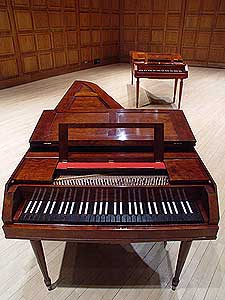|
Audio
Photos
Resources
Your Voice
|
Fortepianos: a link in a musical evolutionary chain
February 5, 2004
Most people know the modern piano evolved from the harpsichord. But few know there was an intermediate instrument, called the fortepiano. This weekend at the College of St Scholastica in Duluth, concert goers will have a rare opportunity to hear Mozart music played the way as he might have heard it himself.
Duluth, Minn. — The fortepiano is considered the first version of the modern piano - but it's still remarkably different. Fortepianos appeared in the 1700s - in Mozart and Beethoven's time. Physically, the fortepiano is smaller than its modern counterpart. It has fewer keys - just four or five octaves - and it sounds a lot like a harpsichord.
 | |||
But the fortepiano represented a big leap from the harpsichord, according to LeAnn House, a Professor of Music at Duluth's College of St. Scholastica. Press a harpsichord key and it plucks a string. In a fortepiano, a hammer strikes the string, then rebounds away, leaving the string to vibrate.
"This can emote in a different kind of way," House says. "I can phrase," House says.
She plays an example - a few notes.
"I can play one note loud, and the next note soft. I can't do that on a harpsichord."
Like the harpsichord, the fortepiano is delicate. Its strings are mounted on wood. A modern piano uses steel supports. The fortepiano has to be tuned and retuned, for virtually every use.
There was a musical revolution of sorts going on in the 18th century. Orchestras were moving from small intimate concerts for the rich and powerful, into public concert halls.
For the first time, music was available to the masses, and instruments had to become louder to fill the hall. Fortepianos began sprouting foot pedals and additional keys, becoming eventually, in the 1800s, the modern piano.
"You find composers wanting greater and greater 'expressivity'" House says. "Wanting more notes so they can do more with it - wanting more sounds so they can play with a larger orchestra. It's the sort of gradual 19th century 'More! More! More!' And, of course, every time you get something new, you also lose something."
|
If you're using the analogy to a singer, of the difference between amazing tone and gorgeous diction. And the modern piano has amazing tone. And this (the fortepiano) has fabulous diction."
- LeAnn House, a Professor of Music at Duluth's College of St. Scholastica compares a modern piano with a fortepiano |
Fortepianos actually tune more true than a modern piano. They put out a tighter sound with few harmonics and overtones.
"So, you'll have cleaner fifths," says House.
She plays an example.
"Cleaner fifths," she says. "It's much cleaner. If you compare that to a modern instrument, you won't hear the same kind of beats."
To a listener, House says, it sounds straighter - it sounds more pure.
"This music - you might think if you're using the analogy to a singer, of the difference between amazing tone and gorgeous diction," says House. "And the modern piano has amazing tone. And this piano (the fortepiano) has fabulous diction."
Saturday night's performance will feature a pair of the fortepianos - both replicas based on Stein models - the pianos favored by Mozart. Leanne House will be at one keyboard, and Duluth's Jeanne Doty at the other. Doty says playing this music on period instruments takes her back through the centuries.
"And for me, it's been totally delightful to be able to experience these subtleties of articulation, and nuance, and be able to enjoy this lighthearted concerto by Mozart," says Doty.
Saturday's concert is performed by the Early Music Orchestra - a Duluth based group specializing in classical music as it was played when it was written. The fortepianos will be featured in a performance of Mozart's Concerto for two pianos, and in Mozart's Symphony No. 40.
The performance is in the College of St. Scholastica's Mitchell Auditorium. Organizers says it will be a rare opportunity to hear this music the way Mozart intended more than two hundred years ago.
|
News Headlines
|
Related Subjects
|

